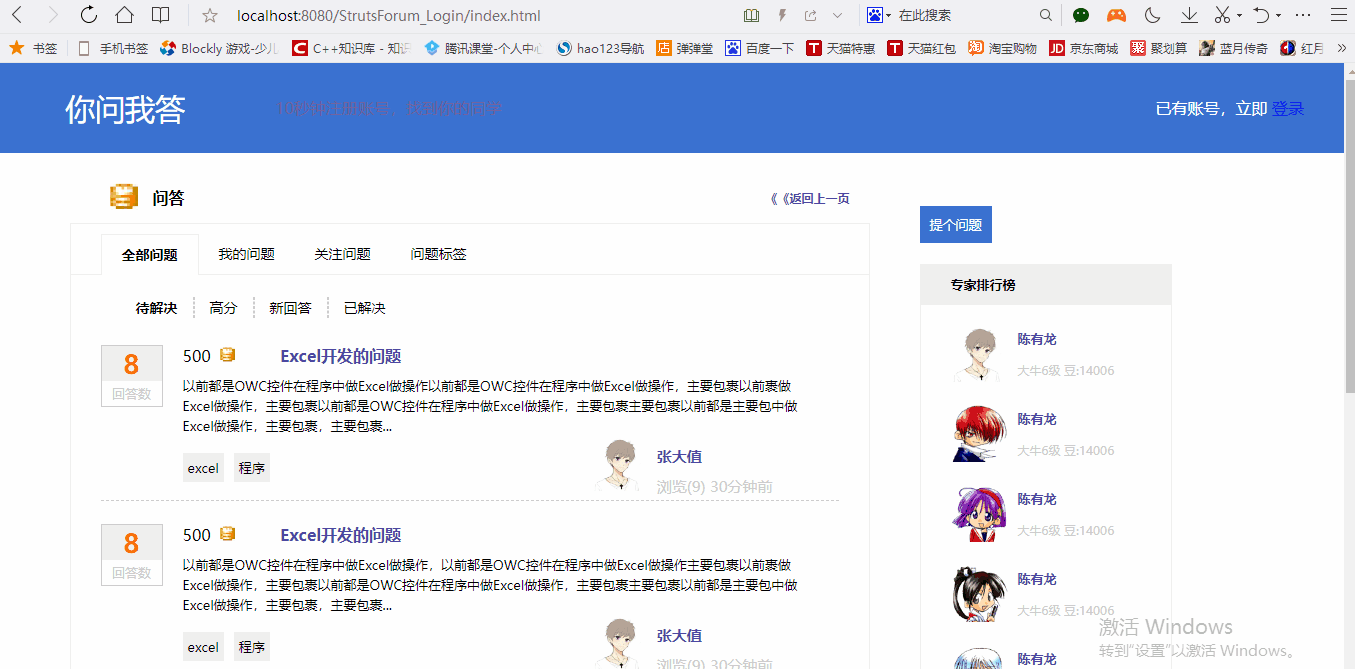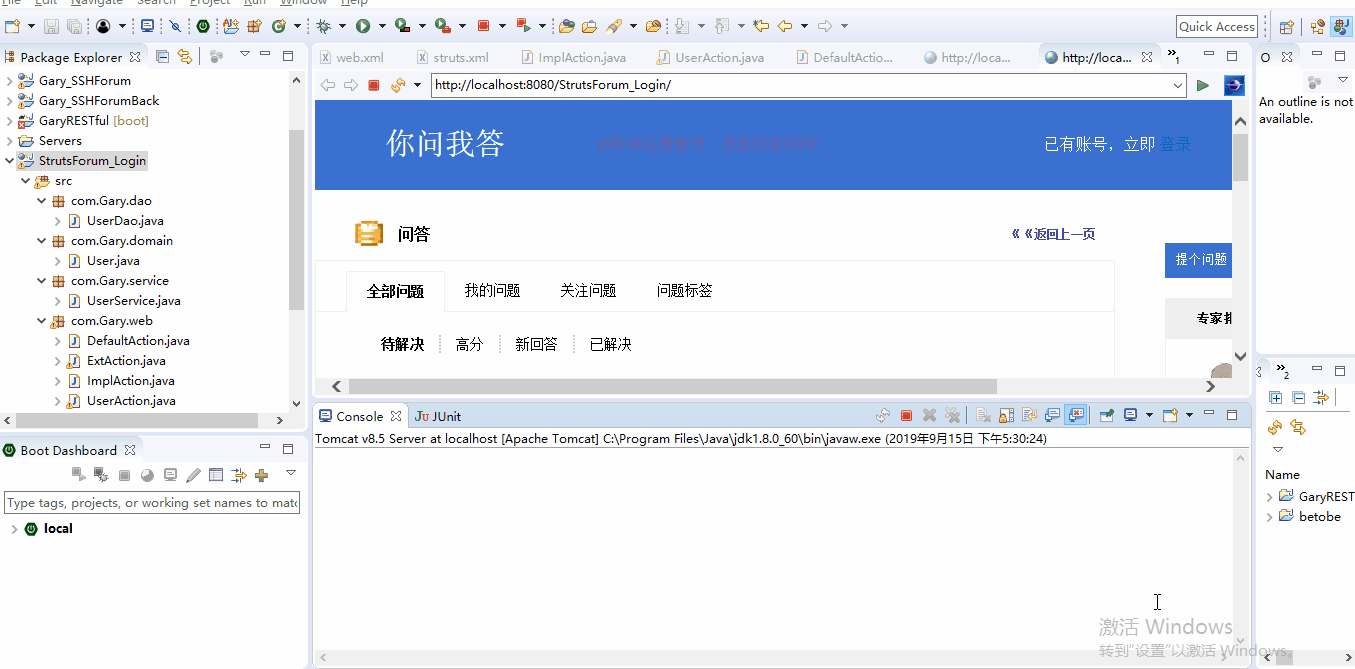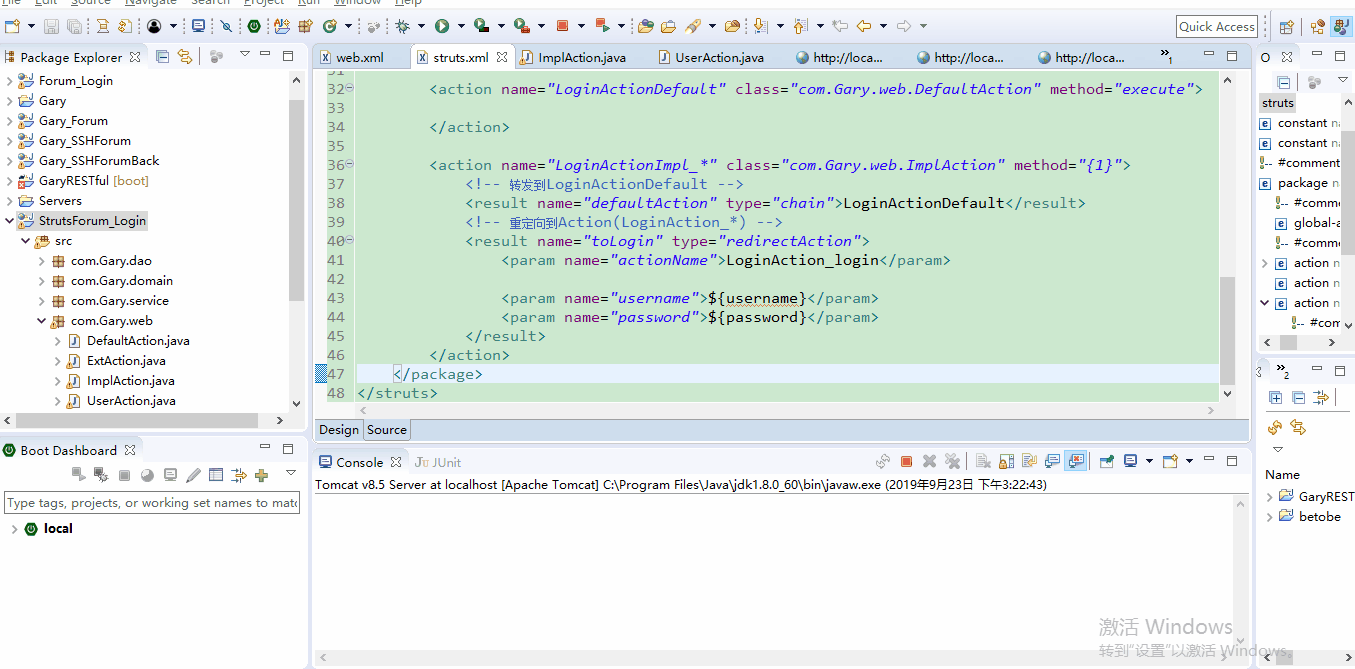此系列博文基于同一个项目已上传至github 传送门
JavaWeb_(Struts2框架)Struts创建Action的三种方式 传送门
JavaWeb_(Struts2框架)struts.xml核心配置、动态方法调用、结果集的处理 传送门
JavaWeb_(Struts2框架)Log4j的配置以及解决中文乱码 传送门
JavaWeb_(Struts2框架)参数传递之接收参数与传递参数 传送门
JavaWeb_(Struts2框架)Ognl小案例查询帖子 传送门
JavaWeb_(Struts2框架)Action中struts-default下result的各种转发类型 传送门
JavaWeb_(Struts2框架)拦截器interceptor 传送门
核心配置
动态方法调用
结果集处理
一、核心配置
struts.xml
<!-- name:配置包名 namespace:给action的访问路径定义一个命名空间 --> <package name="MyPackage" namespace="/user" extends="struts-default"> <!-- action:配置action类 name:决定了action访问的资源名称 servlet:url-pattern class:action的完整类名 method:指定调用action中的哪个方法来去处理请求--> <action name="LoginAction" class="com.Gary.web.UserAction" method="execute"> <!-- 默认为转发 redirect设置为重定向--> <result name="success" type="redirect">/index.html</result> <result name="error">/login.jsp</result> </action> </package>
namespace:作用是可以让不同的packet里面包含相同action名称,起虚拟路径作用
<package name="MyPackage" namespace="/" extends="struts-default"></package>
此时访问的路径http://localhost:8080/项目名字/请求
<package name="MyPackage" namespace="/user" extends="struts-default">
此时访问路径此时访问的路径http://localhost:8080/项目名字/user/请求
二、动态方法调用
在web层UserAction.java类中编写login()注册方法
<action name="LoginAction" class="com.Gary.web.UserAction" method="login"> <!-- 默认为转发 redirect设置为重定向 --> <result name="success" type="redirect">/index.html</result> <result name="error">/login.jsp</result> </action>
public String login() throws Exception { System.err.println("login()方法"); UserService userService = new UserService(); boolean success = userService.findUser(user); if(success) { return "success"; }else{ ServletActionContext.getRequest().setAttribute("error", "用户名或密码错误!!!"); return "error"; } }
在web层UserAction.java类中编写register()注册方法
<action name="LoginActionRegister" class="com.Gary.web.UserAction" method="register"> <!-- 默认为转发 redirect设置为重定向 --> <result name ="success" type="redirect">/index.html</result> <result name ="error">/login.jsp</result> </action>
//注册 public String register() throws Exception { System.err.println("register()方法"); return null; }
此时,如果想要访问com.Gary.web.UserAction路径下的login方法,就需要调用http://localhost:8080/StrutsForum_Login/LoginAction,如果想要访问com.Gary.web.UserAction路径下的register方法,就需要调用http://localhost:8080/StrutsForum_Login/LoginActionRegister。


package com.Gary.web; import org.apache.struts2.ServletActionContext; import com.Gary.domain.User; import com.Gary.service.UserService; import com.opensymphony.xwork2.ActionSupport; import com.opensymphony.xwork2.ModelDriven; public class UserAction extends ActionSupport implements ModelDriven<User>{ public User user = new User(); public String login() throws Exception { System.err.println("login()方法"); UserService userService = new UserService(); boolean success = userService.findUser(user); if(success) { return "success"; }else{ ServletActionContext.getRequest().setAttribute("error", "用户名或密码错误!!!"); return "error"; } } //注册 public String register() throws Exception { System.err.println("register()方法"); return null; } @Override public User getModel() { // TODO Auto-generated method stub return user; } }

<?xml version="1.0" encoding="UTF-8"?> <!DOCTYPE struts PUBLIC "-//Apache Software Foundation//DTD Struts Configuration 2.5//EN" "http://struts.apache.org/dtds/struts-2.5.dtd"> <struts> <!-- name:配置包名 namespace:给action的访问路径定义一个命名空间 --> <package name="MyPackage" namespace="/" extends="struts-default"> <!-- action:配置action类 name:决定了action访问的资源名称 servlet:url-pattern class:action的完整类名 method:指定调用action中的哪个方法来去处理请求 --> <action name="LoginAction" class="com.Gary.web.UserAction" method="login"> <!-- 默认为转发 redirect设置为重定向 --> <result name="success" type="redirect">/index.html</result> <result name="error">/login.jsp</result> </action> <action name="LoginActionRegister" class="com.Gary.web.UserAction" method="register"> <!-- 默认为转发 redirect设置为重定向 --> <result name ="success" type="redirect">/index.html</result> <result name ="error">/login.jsp</result> </action> <action name="LoginActionDefault" class="com.Gary.web.DefaultAction" method="execute"> </action> <action name="LoginActionImpl" class="com.Gary.web.ImplAction" method="execute"> </action> </package> </struts>
如果每一个方法就需要在struct.xml中配置一个<action>,那配置多个方法时就有一些麻烦了,此时我们可以用到struct框架中的动态方法调用
使用动态方法调用一定注意在struct.xml中添加两行<constant>标签和一行<global-allowed-methods>
<constant name="struts.devMode" value="true"></constant> <constant name="struts.enable.DynamicMethodInvocation" value="true"></constant> <!-- 增加动态方法调用的安全性 --> <global-allowed-methods>login,register,kill</global-allowed-methods>
三、结果集
<action name="LoginAction_*" class="com.Gary.web.UserAction" method="{1}">
<!-- 默认为转发 redirect设置为重定向 -->
<result name="success" type="redirect">/index.html</result>
<!-- 默认为转发 -->
<result name="error">/login.jsp</result>
</action>
转发到Action【转发的路径是不会变的】
在struct.xml中配置动态方法调用
<action name="LoginActionDefault" class="com.Gary.web.DefaultAction" method="execute"> </action> <action name="LoginActionImpl" class="com.Gary.web.ImplAction" method="execute"> <!-- 转发到LoginActionDefault --> <result name="defaultAction" type="chain">LoginActionDefault</result> </action>
ImplAction.java中编写execute()方法
@Override public String execute() throws Exception { System.out.println("这是实现了Action接口的action"); return "defaultAction"; }


package com.Gary.web; import com.opensymphony.xwork2.Action; public class ImplAction implements Action{ @Override public String execute() throws Exception { System.out.println("这是实现了Action接口的action"); return "defaultAction"; } }

<?xml version="1.0" encoding="UTF-8"?> <!DOCTYPE struts PUBLIC "-//Apache Software Foundation//DTD Struts Configuration 2.5//EN" "http://struts.apache.org/dtds/struts-2.5.dtd"> <struts> <constant name="struts.devMode" value="true"></constant> <constant name="struts.enable.DynamicMethodInvocation" value="true"></constant> <!-- name:配置包名 namespace:给action的访问路径定义一个命名空间 --> <package name="MyPackage" namespace="/" extends="struts-default"> <!-- 增加动态方法调用的安全性 --> <global-allowed-methods>login,register,kill</global-allowed-methods> <!-- action:配置action类 name:决定了action访问的资源名称 servlet:url-pattern class:action的完整类名 method:指定调用action中的哪个方法来去处理请求 --> <action name="LoginAction_*" class="com.Gary.web.UserAction" method="{1}"> <!-- 默认为转发 redirect设置为重定向 --> <result name="success" type="redirect">/index.html</result> <!-- 默认为转发 --> <result name="error">/login.jsp</result> </action> <action name="LoginActionDefault" class="com.Gary.web.DefaultAction" method="execute"> </action> <action name="LoginActionImpl" class="com.Gary.web.ImplAction" method="execute"> <!-- 转发到LoginActionDefault --> <result name="defaultAction" type="chain">LoginActionDefault</result> </action> </package> </struts>
重定向到Action【转发的路径是不会变的】
在struts.xml中添加"toLogin"结果集,配置type="redirectAction"
<action name="LoginActionImpl_*" class="com.Gary.web.ImplAction" method="{1}"> <!-- 转发到LoginActionDefault --> <result name="defaultAction" type="chain">LoginActionDefault</result> <!-- 重定向到Action(LoginAction_*) --> <result name="toLogin" type="redirectAction"> <param name="actionName">LoginAction_login</param> <param name="username">${username}</param> <param name="password">${password}</param> </result> </action>
在ImplAction.java中添加login()方法,return去发起toLogin请求
public String login() { //得到原生的request域 //ServletActionContext.getRequest().setAttribute("username", "123"); //ServletActionContext.getRequest().setAttribute("password", "123"); ActionContext.getContext().put("username", "123"); ActionContext.getContext().put("password", "123"); return "toLogin"; }
运行程序,在网页的url中输入http://localhost:8080/StrutsForum_Login/LoginActionImpl_login请求,请求后【http://localhost:8080/StrutsForum_Login/LoginAction_login路径不变


package com.Gary.web; import org.apache.struts2.ServletActionContext; import com.opensymphony.xwork2.Action; import com.opensymphony.xwork2.ActionContext; public class ImplAction implements Action{ @Override public String execute() throws Exception { System.out.println("这是实现了Action接口的action"); return "defaultAction"; } public String login() { //得到原生的request域 //ServletActionContext.getRequest().setAttribute("username", "123"); //ServletActionContext.getRequest().setAttribute("password", "123"); ActionContext.getContext().put("username", "123"); ActionContext.getContext().put("password", "123"); return "toLogin"; } }

<?xml version="1.0" encoding="UTF-8"?> <!DOCTYPE struts PUBLIC "-//Apache Software Foundation//DTD Struts Configuration 2.5//EN" "http://struts.apache.org/dtds/struts-2.5.dtd"> <struts> <constant name="struts.devMode" value="true"></constant> <constant name="struts.enable.DynamicMethodInvocation" value="true"></constant> <!-- name:配置包名 namespace:给action的访问路径定义一个命名空间 --> <package name="MyPackage" namespace="/" extends="struts-default"> <!-- 增加动态方法调用的安全性 --> <global-allowed-methods>regex:.*</global-allowed-methods> <!-- action:配置action类 name:决定了action访问的资源名称 servlet:url-pattern class:action的完整类名 method:指定调用action中的哪个方法来去处理请求 --> <action name="LoginAction_*" class="com.Gary.web.UserAction" method="{1}"> <!-- 默认为转发 redirect设置为重定向 --> <result name="success" type="redirect">/index.html</result> <!-- 默认为转发 --> <result name="error">/login.jsp</result> </action> <action name="LoginActionDefault" class="com.Gary.web.DefaultAction" method="execute"> </action> <action name="LoginActionImpl_*" class="com.Gary.web.ImplAction" method="{1}"> <!-- 转发到LoginActionDefault --> <result name="defaultAction" type="chain">LoginActionDefault</result> <!-- 重定向到Action(LoginAction_*) --> <result name="toLogin" type="redirectAction"> <param name="actionName">LoginAction_login</param> <param name="username">${username}</param> <param name="password">${password}</param> </result> </action> </package> </struts>
